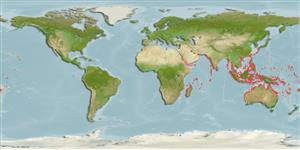>
Carangiformes (Jacks) >
Carangidae (Jacks and pompanos) > Trachinotinae
Etymology: Trachinotus: Greek, trachys, -eia, -ys = rough + Greek,noton = back (Ref. 45335).
Eponymy: Marcus Élieser Bloch (1723–1799) was a German physician and naturalist specialising in ichthyology. [...] (Ref. 128868), visit book page.
More on author: Lacepède.
Environment: milieu / climate zone / depth range / distribution range
Ökologie
seewasser; brackwasser riff-verbunden; tiefenbereich 1 - 7 m (Ref. 5439). Tropical; 31°N - 35°S, 30°E - 157°W
Indo-Pacific: Red Sea and East Africa (Ref. 3287) to the Marshall Islands and Samoa, north to southern Japan, south to Australia.
Length at first maturity / Size / Gewicht / Alter
Maturity: Lm ?, range 58 - ? cm
Max length : 110 cm FL Männchen/unbestimmt; (Ref. 1602); common length : 40.0 cm TL Männchen/unbestimmt; (Ref. 3280); max. veröff. Gewicht: 3.4 kg (Ref. 40637)
Rückenflossenstacheln (insgesamt) : 7; Rückenflossenweichstrahlen (insgesamt) : 18 - 20; Afterflossenstacheln: 3; Afterflossenweichstrahlen: 16 - 18.
Juveniles inhabit sandy shorelines and shallow sandy or muddy bays near river mouths while adults move out in schools to clear seaward coral and rock reefs (Ref. 5213). Juveniles are in small schools, while adults are usually solitary (Ref. 48635). Adults feed primarily on sand mollusks and other hard-shelled invertebrates (Ref. 9710).
Paxton, J.R., D.F. Hoese, G.R. Allen and J.E. Hanley, 1989. Pisces. Petromyzontidae to Carangidae. Zoological Catalogue of Australia, Vol. 7. Australian Government Publishing Service, Canberra, 665 p. (Ref. 7300)
IUCN Rote Liste Status (Ref. 130435: Version 2024-2)
Bedrohung für Menschen
Reports of ciguatera poisoning (Ref. 30911)
Nutzung durch Menschen
Fischereien: weniger kommerziell; Aquakultur: kommerziell; Sportfisch: ja; Aquarium: Öffentliche Aquarien
Tools
Zusatzinformationen
Download XML
Internet Quellen
Estimates based on models
Preferred temperature (Ref.
123201): 24.8 - 29.3, mean 28.4 °C (based on 3759 cells).
Phylogenetic diversity index (Ref.
82804): PD
50 = 0.5000 [Uniqueness, from 0.5 = low to 2.0 = high].
Bayesian length-weight: a=0.02630 (0.01463 - 0.04729), b=2.83 (2.68 - 2.98), in cm total length, based on LWR estimates for this species & Genus-body shape (Ref.
93245).
Trophic level (Ref.
69278): 3.8 ±0.36 se; based on food items.
Widerstandsfähigkeit (Ref.
120179): mittel, Verdopplung der Population dauert 1,4 - 4,4 Jahre. (Assuming tm=2-4).
Fishing Vulnerability (Ref.
59153): High to very high vulnerability (73 of 100).
Climate Vulnerability (Ref.
125649): Very high vulnerability (93 of 100).
Nutrients (Ref.
124155): Calcium = 34.7 [14.6, 65.4] mg/100g; Iron = 0.575 [0.303, 1.202] mg/100g; Protein = 19.7 [17.7, 21.7] %; Omega3 = 0.0854 [, ] g/100g; Selenium = 27.9 [14.2, 59.5] μg/100g; VitaminA = 27.7 [6.5, 105.1] μg/100g; Zinc = 0.919 [0.590, 1.375] mg/100g (wet weight); based on
nutrient studies.
